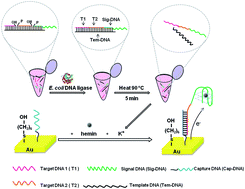Ultrasensitive electrochemical detection of dual DNA targets based on G-quadruplex-mediated amplification†
Abstract
A novel strategy was established for simultaneous electrochemical detection of dual target DNAs. A template DNA was firstly designed to be complementary to target DNA 1, target DNA 2, and part of signal DNA, which contains a G-quadruplex forming sequence. In the presence of both target DNAs and signal DNA, these sequences hybridized with template DNA and were further ligated together to form a long strand under the catalysis of E. coli DNA ligase. After denaturation, the ligated sequence was dehybridized with template DNA and captured with a capture probe immobilized on the surface of a gold electrode. With the help of hemin, a G-quadrupelx–hemin complex can be formed on the surface of the gold electrode which produced a remarkable electrochemical signal. Therefore, the proposed DNA sensor was used to simultaneously detect dual target DNAs with extremely high sensitivity. For target DNA 1 and target DNA 2, detection limits of 100 fM and 7.4 fM were achieved respectively. The specificity of the sensor was verified by employing one-base mismatched and three-base mismatched sequences. In consideration of its potential for multiplex DNA sequence detection, the proposed DNA sensor may have great potential in the fields of microbial identification, disease diagnosis, food quality control and environmental monitoring.


 Please wait while we load your content...
Please wait while we load your content...